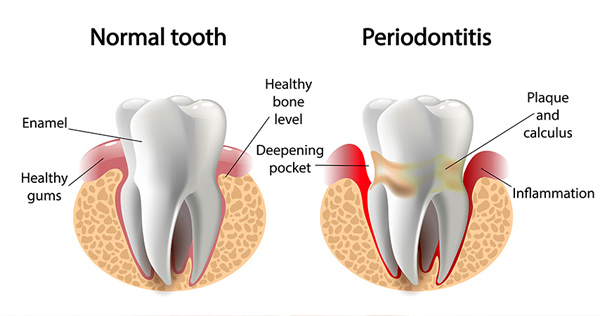Periodontist Near You
Periodontal diseases are chronic bacterial infections that affect the gum and bone supporting the teeth.
They are caused mainly by the accumulation of plaque on all surfaces of the teeth and result in swelling within the supporting tissue.
Periodontics can be managed through the maintenance of health, the diagnosis and treatment of gum disease, as well as the placement of dental implants.
What is it?
Gum disease affects the attachment between gums and teeth. It forms from the accumulation of plaque and bacteria on your teeth and where your teeth and gums meet. If not removed by daily maintenance, it hardens into tartar, which cannot be removed by brushing or flossing.
What happens?
Prevention & Maintenance
Prevention is the best cure. Gum disease can be prevented, and even reversed when caught in the early stages. By having a regular dental exam and professional cleaning, you could catch and treat it before it becomes a major problem.
Diagnosis of gum disease
The two most common types of gum disease are gingivitis and periodontitis.
The early stage of gum disease is called gingivitis. This is when there is an infection where the gums attach to the teeth. Scaling and root planning are effective ways to treat gum disease in its early stages. Untreated gingivitis can develop into periodontitis, which refers to gum disease and the destruction of tissue and/or bone.
Periodontics Treatment
In the earlier stages of gum disease, professional cleaning is the best solution. This can be done by your general dentist or dental hygienist. In the more serious stages, treatment by a periodontist is required. Periodontists specialize in the treatment of gum disease and the restoration of bone and gum tissue that has been lost due to this disease.
Prevention & Maintenance
Prevention is the best cure. Gum disease can be prevented, and even reversed when caught in the early stages. By having a regular dental exam and professional cleaning, you could catch and treat it before it becomes a major problem.
Diagnosis of gum disease
The two most common types of gum disease are gingivitis and periodontitis.
The early stage of gum disease is called gingivitis. This is when there is an infection where the gums attach to the teeth. Scaling and root planning are effective ways to treat gum disease in its early stages. Untreated gingivitis can develop into periodontitis, which refers to gum disease and the destruction of tissue and/or bone.
Periodontics Treatment
In the earlier stages of gum disease, professional cleaning is the best solution. This can be done by your general dentist or dental hygienist. In the more serious stages, treatment by a periodontist is required. Periodontists specialize in the treatment of gum disease and the restoration of bone and gum tissue that has been lost due to this disease.

You need to know
Appointments
- At least 2 appointments
- During the first visit, our dentist in Vancouver will evaluate your gum inflammation, examine the space between the gum and the tooth, and measure the gum recession.
- The next visit will be for the treatment.
- You may need additional appointments if the treatment is more complex or for them to assess the success of the treatment.
How long does it take?
- Treatment appointments will usually be at least 1 hour, however, they will vary depending on the treatment you need
You may be asked about
- Your dental history and medical history
- Your oral health care routine at home
After your appointment
- If you have had anaesthesia, you will still feel a bit numb for the next couple of hours.
- With most treatments avoid eating very hot or very cold foods – a soft food diet is usually recommended after treatment.
- Avoid drinking alcohol for at least a couple of days.
- Avoid smoking for at least a week following treatment or surgery.
- Follow the care routine prescribed to you by your dentist or dental hygienist.
- You may have some swelling or sensitivity for a couple of days.
- Be gentle brushing your teeth around the treatment area for the first few days.

